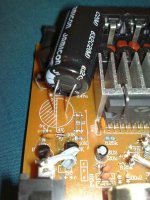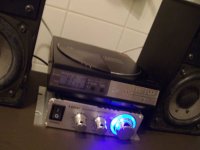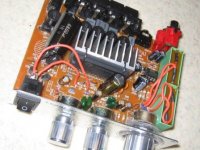Hi Aszu, happy you had good results with the tweaks. I agree, how can this little ugly thing sound SO good?
The little film cap is
"used to bypass (shunt) unwanted signals to the ground. A common use is in power supplies where a bypass capacitor is connected in parallel with the main filter capacitor to shunt noise and other high frequency interference to ground which the main capacitor may not be able to do."
http://wiki.answers.com/Q/What_is_the_function_of_a_bypass_capacitor_in_an_amplifier
It is a very common practice.
Please look for a film input cap, you can find it very easily on e*ay and you'll certainly notice the improvement in sound. If you PM me I'll send you with pleasure a pair of my NOS Wima MKA.
Finally please allow some burn in time to get a very full bass.
The little film cap is
"used to bypass (shunt) unwanted signals to the ground. A common use is in power supplies where a bypass capacitor is connected in parallel with the main filter capacitor to shunt noise and other high frequency interference to ground which the main capacitor may not be able to do."
http://wiki.answers.com/Q/What_is_the_function_of_a_bypass_capacitor_in_an_amplifier
It is a very common practice.
Please look for a film input cap, you can find it very easily on e*ay and you'll certainly notice the improvement in sound. If you PM me I'll send you with pleasure a pair of my NOS Wima MKA.
Finally please allow some burn in time to get a very full bass.
the kitchen system
I'm testing the amp in the kitchen (oh yes I love cooking with music). I fixed up an amazing lilliputian vintage system. Actually yesterday I found a glorious Sony D-50, the first portable cdplayer ever...
Ohmygod I want them in every room!
I'm testing the amp in the kitchen (oh yes I love cooking with music). I fixed up an amazing lilliputian vintage system. Actually yesterday I found a glorious Sony D-50, the first portable cdplayer ever...
Ohmygod I want them in every room!
Attachments
Calamaro,
Can I use the same resistors (on board ones) to by pass the tone control or MUST I replace them with 22k resistors?
Also, can I use 0.33uf film capacitors instead of 2.2uf caps, due to the space?
Thanks for your help.
Can I use the same resistors (on board ones) to by pass the tone control or MUST I replace them with 22k resistors?
Also, can I use 0.33uf film capacitors instead of 2.2uf caps, due to the space?
Thanks for your help.
Many thanks for the explanation Calamaro 🙂
I attached this small 100nF film capacitor under the board - very quick and easy job. I didn't expect to hear any difference, but it looks like stereo separation is now a bit better.
Regarding big (2.2uF) film capacitors, I have found this one
Do you think it will do the job?
Are there any other mods of this board you can recommend? 🙂
I attached this small 100nF film capacitor under the board - very quick and easy job. I didn't expect to hear any difference, but it looks like stereo separation is now a bit better.
Regarding big (2.2uF) film capacitors, I have found this one
Do you think it will do the job?
Are there any other mods of this board you can recommend? 🙂
BTW: I am ultra-mega happy with the sound at the moment.. It was amazing before mods, but now it is much more refined, almost perfect 🙂
Bypassing tone controls is definitely a way to go!
Bypassing tone controls is definitely a way to go!
cheric said:
Also, can I use 0.33uf film capacitors instead of 2.2uf caps, due to the space?
I'm pretty sure caps under 2.2uf will start acting like a high-pass filter resulting in rolled off bass.
Yes, that's right. At 2.2uf, the input caps are already acting as hi-pass, but the frequency is low enough not to interfere with the audio range.
Cheric, if you're tight for space, you can parallel two 1.0 uf caps and get something that will work just fine. I remember some people in these forums getting good results with the blue-colored 1.0uf film caps sold at Radio Shack. Also, some film caps are larger than others--usually related to the voltage rating.
BTW, if you know you're only going to use the amp with speakers that don't produce much bass, cutting off the frequencies below which the speakers don't do any useful work is not a bad idea and leaves more energy for frequencies where it does.
--Buckapound
Cheric, if you're tight for space, you can parallel two 1.0 uf caps and get something that will work just fine. I remember some people in these forums getting good results with the blue-colored 1.0uf film caps sold at Radio Shack. Also, some film caps are larger than others--usually related to the voltage rating.
BTW, if you know you're only going to use the amp with speakers that don't produce much bass, cutting off the frequencies below which the speakers don't do any useful work is not a bad idea and leaves more energy for frequencies where it does.
--Buckapound
Thank you Gmorris and Buckapound for quick replies.
I will try to find the 2.2uf caps in a smaller package.
I will try to find the 2.2uf caps in a smaller package.
you can get 2.2uF Hi Quality Metalized / Polypropylene Capacitors from Jaycar (thats the ones I use). They have a UK branch.
https://secure.vividcluster.crox.ne....asp?ID=RY6952&CATID=51&form=CAT&SUBCATID=866
theres a phone number there too.
edit: you can also get the Taiwan Alpha B100K log pots that I used (which are much better quality) from here.
col.
https://secure.vividcluster.crox.ne....asp?ID=RY6952&CATID=51&form=CAT&SUBCATID=866
theres a phone number there too.
edit: you can also get the Taiwan Alpha B100K log pots that I used (which are much better quality) from here.
col.
If you have both the option and the budget the choice scale goes like this:
1st: Polypropylene (often very big and expensive)
2nd: Polyester MKT (much smaller but hard to find in 2.2uF and can be just as expensive as poly, don't sound as good).
3rd: Electorlytic (the cheapest option but can still sound OK)
I wouldn't use Mylar caps as signal input.
col.
1st: Polypropylene (often very big and expensive)
2nd: Polyester MKT (much smaller but hard to find in 2.2uF and can be just as expensive as poly, don't sound as good).
3rd: Electorlytic (the cheapest option but can still sound OK)
I wouldn't use Mylar caps as signal input.
col.
I just want to show off my modded Lepai. It does sound so good, much better than in stock form.
I used Panasonic FC 4700uf near the chip and Panasonic NHG 6800uf for p/s.
The signal input caps are MKT 1822 by Ero. BTW, are these better than the Ero MKC 1862?
A friend gave me a couple of each and I am not sure which are the better ones. They barely fit in the box.
I also used OPA2134 for Opamp. I am ordering the NE5532 to try out, may not be as good.
Those little gold caps are Nichicon 2.2uf "Fine Gold".
I used Panasonic FC 4700uf near the chip and Panasonic NHG 6800uf for p/s.
The signal input caps are MKT 1822 by Ero. BTW, are these better than the Ero MKC 1862?
A friend gave me a couple of each and I am not sure which are the better ones. They barely fit in the box.
I also used OPA2134 for Opamp. I am ordering the NE5532 to try out, may not be as good.
Those little gold caps are Nichicon 2.2uf "Fine Gold".
Attachments
My error.
Near the chip, I used Panasonic FM 1200uf, not the Panasonic FC 4700uf as previously described.
Near the chip, I used Panasonic FM 1200uf, not the Panasonic FC 4700uf as previously described.
Hey guys, just got back, the Lepai works (or worked) great in the car. I say worked as it is no longer working...
I was listening to some quiet music from an MP3 player, so the volume was up high, maybe on full...
A loud song then came on after, I had around 2 seconds of very loud music and then the amp cut out...
Now all I get when unmuting the amp is a ticking noise. The ticking noise goes when it's muted.
What would be the best way of troubleshooting this? Check for DC offset on the outs?
So far I've check the op-amp is getting power, I'll try and find some small caps so I can try bypassing the tone controls to check the tripath chip is getting a signal.
I have a feeling tho that because of the clicking it's the TA 2020 or maybe the output diodes or inductors. Could I have cooked thru an inductor with excessive current?
I was using 4ohm car speakers, with a passive crossover, so not exactly the easiest load for the amp.
I already have another one on it's way that I ordered on Friday, but I'd like to fix this one if possible.
I was listening to some quiet music from an MP3 player, so the volume was up high, maybe on full...
A loud song then came on after, I had around 2 seconds of very loud music and then the amp cut out...
Now all I get when unmuting the amp is a ticking noise. The ticking noise goes when it's muted.
What would be the best way of troubleshooting this? Check for DC offset on the outs?
So far I've check the op-amp is getting power, I'll try and find some small caps so I can try bypassing the tone controls to check the tripath chip is getting a signal.
I have a feeling tho that because of the clicking it's the TA 2020 or maybe the output diodes or inductors. Could I have cooked thru an inductor with excessive current?
I was using 4ohm car speakers, with a passive crossover, so not exactly the easiest load for the amp.

I already have another one on it's way that I ordered on Friday, but I'd like to fix this one if possible.
MikeHunt79 said:Hey guys, just got back, the Lepai works (or worked) great in the car. I say worked as it is no longer working...
I was listening to some quiet music from an MP3 player, so the volume was up high, maybe on full...
A loud song then came on after, I had around 2 seconds of very loud music and then the amp cut out...
Now all I get when unmuting the amp is a ticking noise. The ticking noise goes when it's muted.
What would be the best way of troubleshooting this? Check for DC offset on the outs?
So far I've check the op-amp is getting power, I'll try and find some small caps so I can try bypassing the tone controls to check the tripath chip is getting a signal.
I have a feeling tho that because of the clicking it's the TA 2020 or maybe the output diodes or inductors. Could I have cooked thru an inductor with excessive current?
I was using 4ohm car speakers, with a passive crossover, so not exactly the easiest load for the amp.
I already have another one on it's way that I ordered on Friday, but I'd like to fix this one if possible.
🙁 Sorry to hear that your amp is burnt.🙁 Col is correct, The voltage cannot above 13.5V.
Hoped that the TA-2020 haven't burnt.
For your new amp, you may need to add a resistor to lower down input voltage.
Mike, have you already modded that one? I had one die on me after playing it for about 20mins, luckily I hadn't done any mods on it. I got it from "savebase" on Ebay I sent them an email and they said send it back by normal airmail. Which cost me AUD$12.50 I took a photo of the package in the post office with the stamps on it and emailed them the "proof" of sending. They wrote back and said "your replacement is in the post". It arrived this morning, very fast turn round.
Iv'e finally replaced all the 2.2uF with polyester MKT caps now.
http://pix.minirig.org.au/main.php?g2_itemId=1060
sounding superb now and Iv'e got tone controls! 😉
col.
Iv'e finally replaced all the 2.2uF with polyester MKT caps now.
http://pix.minirig.org.au/main.php?g2_itemId=1060
sounding superb now and Iv'e got tone controls! 😉
col.
Nothing looks burnt, I've even removed the heatsink and there are no black marks anywhere so I think It cold be that one of the output inductors could have gone open circuit... The chip still responds to the mute pin being on and off so I dont think the TA2020 is dead.panda360 said:
🙁 Sorry to hear that your amp is burnt.🙁 Col is correct, The voltage cannot above 13.5V.
Hoped that the TA-2020 haven't burnt.
For your new amp, you may need to add a resistor to lower down input voltage.
Perhaps if the input voltage of the car is too high then a diode in series would drop 0.5v which may be better than a resistor.
Nice work, looks like it will be quite a squeeze in the case.col said:Mike, have you already modded that one? I had one die on me after playing it for about 20mins, luckily I hadn't done any mods on it. I got it from "savebase" on Ebay I sent them an email and they said send it back by normal airmail. Which cost me AUD$12.50 I took a photo of the package in the post office with the stamps on it and emailed them the "proof" of sending. They wrote back and said "your replacement is in the post". It arrived this morning, very fast turn round.
Iv'e finally replaced all the 2.2uF with polyester MKT caps now.
http://pix.minirig.org.au/main.php?g2_itemId=1060
sounding superb now and Iv'e got tone controls! 😉
col.
I have already modded this unit, just the power input mods (cap reaplaced with a 25v 6800uF unit, inductor and diode removed) so I think I'll try to fix it.
I read thru the TA2020 datasheet again today and it has what sounds to be a helpful thing called a fault pin which can be wired up to an LED & resistor, and I'm guessing the LED will flash to show what the fault is...
I think I may also have some high current inductors, that are around 10uH, I'll try swapping these and see if anything happens.

Ok, I've made some progress (I think), I'm getting 5.1v on pins 2 and 8, 1.05v on pin 4 so I think the TA2020 is ok.
I found that a zener diode is wired to pin 18 (fault pin) and I think this is somehow connected to the pin 11 (mute pin), I tried lifting the zener diode where it's connected to pin 18 and no more clicking, yet still no sound despite a small thump when unmuted.
The zener is still out at one side, and I'm now seeing pin 6 (overload) is grounded when I unmute the amp. Here's what it says in the datasheet about pin6: "A logic low indicates the input signal has overloaded the amplifier"
Is "logic low" another way of saying the pin is the same voltage as ground? I also measured from the +12v on my power source, and it was reading at -12v, so it's definately ground, so could it be a fault with the input signal?
I found that a zener diode is wired to pin 18 (fault pin) and I think this is somehow connected to the pin 11 (mute pin), I tried lifting the zener diode where it's connected to pin 18 and no more clicking, yet still no sound despite a small thump when unmuted.
The zener is still out at one side, and I'm now seeing pin 6 (overload) is grounded when I unmute the amp. Here's what it says in the datasheet about pin6: "A logic low indicates the input signal has overloaded the amplifier"
Is "logic low" another way of saying the pin is the same voltage as ground? I also measured from the +12v on my power source, and it was reading at -12v, so it's definately ground, so could it be a fault with the input signal?
have you attached a LED to the fault pin? Is the light on when the amp is unmuted?
edit: try touching the fault pin to the unmute. That should reset it.
col.
edit: try touching the fault pin to the unmute. That should reset it.
col.
- Status
- Not open for further replies.
- Home
- Amplifiers
- Class D
- Lepai T-Amp with TA2020


